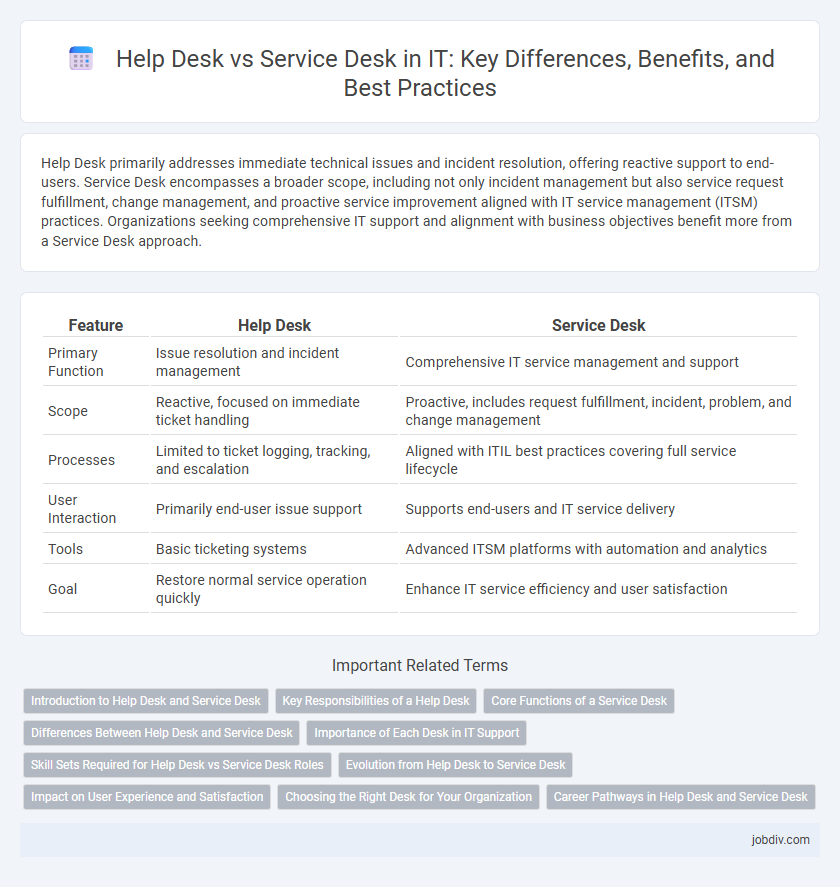Help Desk primarily addresses immediate technical issues and incident resolution, offering reactive support to end-users. Service Desk encompasses a broader scope, including not only incident management but also service request fulfillment, change management, and proactive service improvement aligned with IT service management (ITSM) practices. Organizations seeking comprehensive IT support and alignment with business objectives benefit more from a Service Desk approach.
Table of Comparison
| Feature | Help Desk | Service Desk |
|---|---|---|
| Primary Function | Issue resolution and incident management | Comprehensive IT service management and support |
| Scope | Reactive, focused on immediate ticket handling | Proactive, includes request fulfillment, incident, problem, and change management |
| Processes | Limited to ticket logging, tracking, and escalation | Aligned with ITIL best practices covering full service lifecycle |
| User Interaction | Primarily end-user issue support | Supports end-users and IT service delivery |
| Tools | Basic ticketing systems | Advanced ITSM platforms with automation and analytics |
| Goal | Restore normal service operation quickly | Enhance IT service efficiency and user satisfaction |
Introduction to Help Desk and Service Desk
Help Desk and Service Desk are essential components in IT support, designed to resolve user issues and improve service delivery. Help Desk primarily focuses on incident resolution and user requests, acting as the first point of contact for technical problems. Service Desk offers a broader scope, including incident management, service requests, and change management, aligning IT services with business needs.
Key Responsibilities of a Help Desk
Help Desk key responsibilities include incident management, where technicians diagnose and resolve technical issues such as software glitches, hardware failures, and network connectivity problems. They provide first-level support to end-users by logging, categorizing, and prioritizing tickets, ensuring timely resolution and minimizing downtime. Help Desk teams also assist with password resets, software installations, and basic troubleshooting to maintain seamless IT operations.
Core Functions of a Service Desk
A Service Desk centralizes IT support by managing incident resolution, service requests, and communication between users and IT teams, ensuring alignment with business processes and improving overall service quality. Core functions include incident management, request fulfillment, problem management coordination, and knowledge base maintenance to support faster resolution and prevent recurring issues. Unlike Help Desks, Service Desks provide a broader range of services with a strategic focus on end-to-end IT service management and user satisfaction.
Differences Between Help Desk and Service Desk
Help Desk primarily focuses on resolving immediate technical issues and incidents, offering reactive support to end-users. Service Desk provides a broader scope, encompassing IT service management, including request fulfillment, incident management, and change management, aligned with ITIL practices. The Service Desk acts as a strategic point of contact that ensures continuous service delivery and improvement beyond just troubleshooting.
Importance of Each Desk in IT Support
Help Desk serves as the primary point of contact for immediate IT issue resolution, focusing on incident management and quick troubleshooting to minimize downtime. Service Desk offers a broader scope by integrating IT service management (ITSM) processes, including request fulfillment, problem management, and change management, ensuring comprehensive support aligned with business objectives. Both desks are crucial in IT support, with Help Desk driving operational efficiency and Service Desk enhancing strategic service delivery and user experience.
Skill Sets Required for Help Desk vs Service Desk Roles
Help Desk roles demand strong technical troubleshooting skills, basic IT knowledge, and proficiency in common software and hardware support. Service Desk positions require a broader skill set, including IT service management expertise, customer relationship management, incident and problem resolution, as well as communication and project management abilities. Mastery of ITIL framework principles and advanced analytical skills are essential for Service Desk professionals to manage complex service requests and ensure seamless IT operations.
Evolution from Help Desk to Service Desk
The evolution from Help Desk to Service Desk reflects a strategic shift from reactive issue resolution to proactive service management, incorporating ITIL best practices for enhanced operational efficiency. Service Desks offer integrated support spanning incident management, problem management, and request fulfillment, leveraging automation tools and AI-driven analytics to improve user satisfaction and reduce downtime. This transition enables organizations to align IT services with business objectives, facilitating continuous improvement and digital transformation initiatives.
Impact on User Experience and Satisfaction
Help Desk primarily addresses immediate technical issues, leading to swift resolution that enhances user satisfaction through reduced downtime. Service Desk offers a broader scope, integrating IT service management processes that improve overall user experience by proactively managing incidents, requests, and changes. The comprehensive approach of Service Desk drives higher long-term user engagement and trust compared to the reactive nature of Help Desk operations.
Choosing the Right Desk for Your Organization
Help Desk primarily addresses immediate technical issues and incident resolution, while Service Desk offers a broader scope including IT service management, change management, and user support. Selecting the right desk depends on organizational needs: Help Desk suits businesses requiring quick troubleshooting, whereas Service Desk is ideal for those seeking comprehensive IT service integration and strategic support. Evaluating factors such as service complexity, user demand, and long-term IT goals ensures the optimal choice.
Career Pathways in Help Desk and Service Desk
Help Desk roles typically serve as entry-level positions in IT support, focusing on incident resolution and user support, providing foundational skills for advancing into Service Desk positions. Service Desk careers emphasize broader responsibilities including problem management, service request fulfillment, and collaboration with IT teams, offering pathways into specialized roles such as IT Service Management (ITSM) analysts or system administrators. Progression from Help Desk to Service Desk often involves acquiring certifications like ITIL Foundation, CompTIA A+, and gaining experience in service management tools such as ServiceNow or Jira Service Management.
Help Desk vs Service Desk Infographic

 jobdiv.com
jobdiv.com